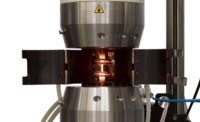We are all acquainted with the various ways that materials break when they are loaded past their limit: the brittle snap of a plastic part or the tearing of a pop top tab are the familiar results of a large overload. A more insidious type of gradual failure can occur when a component is subjected to a cyclic load. In this case, cracks can develop and grow over time even when the peak stresses from the load are much lower than the material’s tensile strength. This type of progressive failure due to multiple applications of load is known as “fatigue.”
While direct cyclic loading of components can be used to evaluate fatigue resistance, testing of small standardized samples of a material is more often performed. The types of test used for this are broadly separated into those that use smooth samples and those which contain a crack. The former combines the entire life cycle of fatigue from the initiation of a crack from a small, sometimes microscopic flaw, through crack growth to failure of the sample. The latter type of test uses a sample that contains a sharp crack. It addresses only the growth stage of the fatigue process. Such fatigue crack growth rate (FCGR) testing provides a relationship between a crack growth parameter, described below, and the associated rate of crack growth. This information can then be used to predict the life of structures containing cracks of known size in locations where stresses can be determined.
Fatigue Crack Growth Specimen
For fatigue crack growth rate testing, a representative sample of material is machined from the material of interest. Specimens typically have a simple shape which contains a notch to concentrate stress in order to grow a crack from a controlled position. One common type of specimen that uses a small amount of material is the “compact tension specimen.”
A machined notch is not acute enough to resemble a natural crack, so as a first step of the test procedure a small fatigue starter crack is grown from the notch at a very low cyclic load to establish a repeatable starting condition approximating a natural crack.
Test Apparatus and Method
FCGR testing is conducted using a servohydraulic test frame. A hydraulic actuator under computer control applies a cyclic force to a specimen which is in turn connected to and measured by a load cell, thereby completing a closed control loop.
The crack growth rate, defined as the change in length of a crack per number of load cycles (“da/dn”), can be determined from visual measurements made at intervals of load application. However, automated methods compatible with computer control are now widely used. Advantages of these automated methods include unattended operation and the ability to gradually speed up or slow down the crack growth rate.
One of the methods of crack length measurement compatible with computer control is the compliance method. This approach uses the change in compliance (a measure of “springiness”) of the sample that occurs as the crack lengthens to calculate a value of crack length. This is done by making measurements of displacement between known locations on the sample along with simultaneous measurements of load. These provide input to a mathematical relationship in the control program specific to the sample that determines crack length as a function of compliance. The sensor that provides the displacement measurement is called a clip gage, which is comprised of two metallic arms instrumented with strain gages. The ends of the arms contain notches that fit into sharp mounting edges on the specimen which are the displacement reference points.
The other commonly used way to determine crack length in metallic samples is the potential drop method where a current of several amperes flows through the specimen in a path that travels around the crack. The electrical resistance of this conductive path creates a small drop in the voltage potential measured at fixed points on the sample. As the crack grows, the length and area of the conductive path changes, which changes the measured potential. The control computer utilizes a functional relationship between crack length and the potential for the specimen geometry to determine a value of crack length.
Results
A parameter called “stress intensity factor,” K, which is a function of remote stress and crack length, describes the stress state near the tip of a crack. The difference in K between the highest and lowest values of a load cycle, ΔK, has been found to correlate with the rate of fatigue crack growth. A typical fatigue crack growth experiment result is shown in the Fatigue Crack Growth Rates graph, where Log(ΔK) is plotted against Log(da/dn). Logarithmic scales are used because fatigue crack growth rates can vary from millions of cycles to advance a crack by one millimeter to only tens of cycles to grow the same distance just before failure. Crack growth rate data enables estimates to be made of the remaining fatigue life of a component before a dangerous crack size is reached.
The overall shape of this curve is characteristic of many materials. At the right of the plot where high values of ΔK are present there is rapid crack growth. In the middle of the plot in the so-called Paris region a linear relationship between Log (ΔK) and the Log (da/dn) is often displayed. For many materials there is a marked decrease in the fatigue crack growth rate for values of ΔK lower than the Paris region. The value of ΔK that corresponds to a crack growth rate is 10-7 mm/cycle or less is called the “threshold” stress intensity. If the combination of load and crack size in a cracked structure results in a ΔK that is less than the threshold value, then for most practical purposes it is the equivalent of a crack which will not grow.
Fatigue crack growth rate information is important to the design process in order to provide a safe lifetime, and essential to the inspection process of critical components to determine the remaining life of a structure when a flaw is found.









